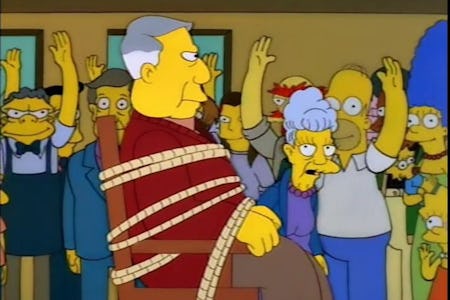25 Years Ago, The Simpsons Dropped Its Most Controversial Episode
It was a perfect show, up until this pivotal moment.

It was the best show on television until Seymour Skinner. No, not that one, the real Seymour Skinner. No, not the real real Seymour Skinner as we know him now, the one that… Look. This is what I mean: The first bad episode of The Simpsons happened 25 years ago. And we’re still reeling.
It was September 28, 1997, and America was settling in for the ninth season of The Simpsons, an incredible TV comedy that hadn’t missed a step since the 1980s and which would seed countless catchphrases and memes into my awkward dates and internet commentary. Just that previous spring, we had laughed at the antics of Frank Grimes, Hank Scorpio, Homer’s insanity pepper trip (featuring Johnny Cash!), and so much more. The show kept getting better and better, even as it seemed like it had already reached its pinnacle.
It was maturing, as well. Since the surprise cliffhanger mystery of “Who Shot Mr. Burns,” The Simpsons began dabbling in episodes that added permanence to the town of Springfield and its cast of characters. These occasional episodes took a more serious (although still hilarious) turn and permanently altered aspects of the show. Lisa became a vegetarian. Homer reunited with his mom. Skinner and Mrs. Krabappel began an ongoing romantic relationship. And in one of The Simpsons’ most amazing episodes ever, Milhouse’s parents got divorced.
The show was handling these episodes with its usual high-quality humor as the subjects became more and more complex, so it’s easy to see how the gigantic misstep of the season 9 episode “The Principal and the Pauper” got as far as it did. The concept of the episode is this: Principal Seymour Skinner has been an imposter this entire time. He was really a no-good punk named Armin Tamzarian and during a fracas in Vietnam, he stole the identity of his presumed-dead commander. The commander was actually alive, and he shows up in Springfield and tries to resume his old life. Sorry, does this sound boring? That’s because it is. (Ten years later, Mad Men, one of the sexiest shows ever, would also have a hard time making this storyline interesting.)
Still, even with that hokey plot, The Simpsons could have spun gold out of “The Principal and the Pauper”. It had been done so many, many times before, and this episode was headed up by writer Ken Keeler who would go on to write some of Futurama’s best episodes. It starts off well enough. The real Seymour Skinner, played by Martin Sheen, is warm but joyless in a way that makes him a perfect foil. However, instead of bouncing off of that, the rest of the episode becomes a largely serious exploration of how Skinner’s deception affects everyone in Springfield, particularly Skinner’s mother Agnes (who has never been a sympathetic character so now the episode has two joyless piles of misery eating up screen time). It’s well-written and honest to The Simpsons’ characters — even as it entirely rewrites one of them–but at no point is it funny.
And that’s the biggest reason why “The Principal and the Pauper” brought the show to such a baffling halt. It wasn’t funny, it was just mean, and the ending of the episode inadvertently made you complicit in its viciousness. Ultimately, the citizens of Springfield decide to force things back to normal by tying the real Skinner to a departing train and legally declaring that Tamzarian’s theft of an entire life is fine. And, well, yeah we as the viewers wanted things to go back to normal once the episode was over, but…this was just heartless.
The Simpsons would continue to churn out classics after “The Principal and the Pauper.” Later episodes give us Max Power, “Behind The Laughter,” Powersauce bars, and the “Simpson gene.” But this is where the show’s slow downturn began, and it never returned to its earlier comedic heights. It was never quite itself again, no matter how many subsequent seasons we waited.
Could this turning point explain the slight generational divide between aging millennials who still love The Simpsons and a possibly disinterested Gen-Z? If you weren’t watching The Simpsons religiously before 1997, you might be confused by its general inconsistency well into the 21st century. A general sampling of random Simpsons episodes is dangerous for a newcomer. But, if you fire an arrow into the episodes before this one you hit a funny episode almost every time. If you do that after this episode, you almost never do.
This is all the more bizarre considering that the events in the episode aren’t really considered “canon” any longer. Series creator Matt Groening notes that he considers the episode a “mistake” and the show itself would declare the events apocryphal almost 18 years (!!) later in an episode titled “Walking Big & Tall,” which depicts the Seymour Skinner that we know growing up with his mother Agnes.
Seymour Skinner was Seymour Skinner all along! We just had to wait until, ah, 2015 to be sure.
The Simpsons streams on Disney+.
This article was originally published on